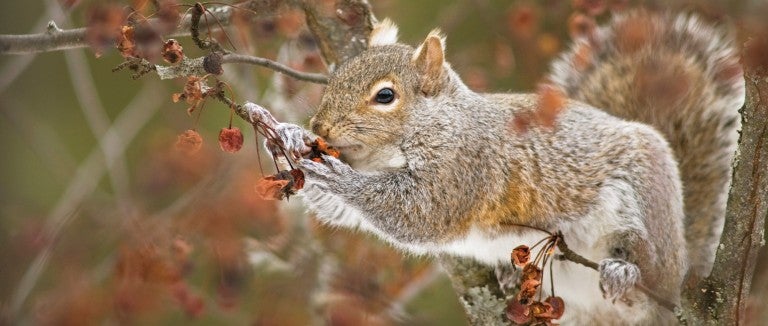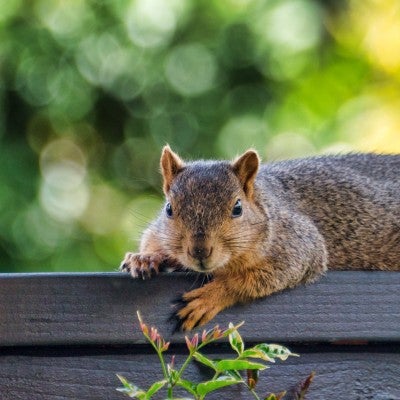There are more than 200 squirrel species, but you’ve most likely only seen the most common in North America: Grey and black squirrels. Squirrels are fascinating to watch, photograph and study, and unlike most wildlife, they aren’t shy! But their adaptable nature means they’re adept at finding the easiest, best sources of food and shelter, even if that food is your bird feeder and that shelter is your attic.
If you've got squirrels driving you nutty (pun totally intended), remember that they're only doing what's natural: looking for a meal and a safe place to sleep at night. Whether you’d like to stop squirrels from stealing your bird seed or you need to evict a squirrel from your attic, try these humane conflict solutions that won’t harm the squirrel or their young.
Contents
- How can I squirrel-proof my bird feeder?
- How can I get rid of squirrels in my yard?
- What should I do if there’s a squirrel loose in my house?
- How can I get rid of squirrels in my attic? How do I keep squirrels out of my house?
- How can I get a squirrel out of my chimney?
- What do squirrels eat? What should I feed squirrels?
- Are squirrels harmful?
How can I squirrel-proof my bird feeder?
Where possible, a little seed for squirrels and more for the birds is a good compromise. If squirrels are taking more than their share, try using a feeder with an external cage that prevents squirrels and larger birds from getting at the food or a feeder with large plastic dome called a “baffle.” The squirrel tries to climb onto the feeder and encounters the baffle, which blocks their access. When they try to push their past the baffle, it rotates, dumping them onto the ground.
You can also suspend the feeder from a horizontal wire strung with homemade bottle baffles. Here’s how to make a homemade, squirrel-deterring bird feeder:
- Attach each end of a wire to trees or posts.
- Puncture a hole in the bottom of three or four clean, empty 1 liter soda bottles.
- Slide the bottles onto the wire.
- Hang your feeder on the wire between bottles.
However, some squirrels figure out that they can just launch themselves at baffles, bounce off and eat the resulting seeds that are spilled on the ground, so you can also try offering bird seed that squirrels don’t like, such as:
- Safflower seed, which attracts species such as cardinals, chickadees and titmice.
- Nyjer thistle, which nourishes goldfinches and others of their kind.
- White proso millet seed, which mourning doves and house finches prefer.
- Capsaicin-covered seed, which irritates squirrels’ mouths but doesn’t affect birds, mixed with your usual seed. (Try kinder methods first.)
A word of caution: “Solutions” that stick to or shock squirrels are cruel and may also harm birds.
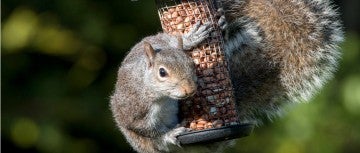
How can I get rid of squirrels in my yard?
You can’t and shouldn’t get rid of squirrels in your yard, but you can try to thwart them using these methods for common squirrel-related yard complaints:
- Trees: Protect dwarf or semi-dwarf fruit and nut trees by netting the entire tree for the short period when squirrel damage is most likely; protect individual clusters of fruit using individual net or paper bags sold as “fruit protection bags.” For taller trees, many orchardists use sheet metal or even pie plate baffles taped to the trunk of each tree. Use trunk baffles only during the short time fruit is ripe to avoid damaging the tree’s trunk.
- Flower bulbs: Squirrels will dig up and eat tulip and crocus bulbs, but they don't like daffodils, so consider investing your bulb-planting energies in daffodils. For other bulbs, soak them in a repellent with Thiram as the active ingredient (and labeled for use as a squirrel repellent) before planting. Lay chicken wire over the planting bed or use wire bulb cages.
- Lawns: Squirrels bury or cache their winter food supply and rely on their incredible sense of smell to relocate their buried treasure. Any "damage" they create is likely to be so slight that tolerance and time are all you need. The lawn will heal itself by spring. Just consider it free aeration for your lawn!
- Wood decks and furniture: If squirrels are gnawing on deck railings or wooden lawn furniture, try capsaicin-based repellents or lightly rubbing the exposed surfaces with a bar of soap.
No matter how big or small your outdoor space, you can create a haven for local wildlife. By providing basic needs like water, food and shelter, you can make a difference in your own backyard.
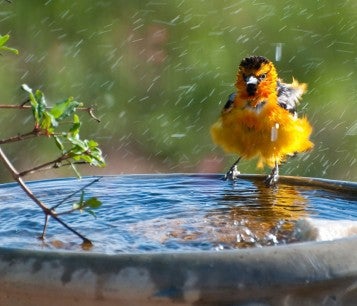
What should I do if there’s a squirrel loose in my house?
A squirrel who has entered a house is there by accident and will be desperate to get out. Place any pets in another room. Close all interior doors and open a window or exterior door in the room. Leave the squirrel alone, so they can find their way out. (They can jump from a second-story window onto a lawn without harming themselves, but don’t let them jump onto concrete.)
If there is no possible exit, set a humane trap baited with peanut butter on the floor near the squirrel and leave them alone for a few hours, then release the trapped squirrel outside. (Relocating them further is inhumane.) If obtaining a trap isn’t an option, try this method:
- Put on heavy gloves.
- Slowly approach the squirrel with the blanket held in front of your body, so that they don’t see a human form.
- Drop the blanket on the squirrel and quickly roll it up, taking care not to put too much weight or pressure on them.
- Take the squirrel in the blanket immediately outside and gently open the blanket on the ground, letting the squirrel escape.
- Once the squirrel is gone, look for and seal any potential entry points.
How can I get rid of squirrels in my attic? How do I keep squirrels out of my house?
Usually, squirrels living in attics are nesting adult females. They often build their nests near openings, such as an unscreened vent or loose or rotten trim boards, and you’ll hear scampering noises as they come and go. Juvenile squirrels may also fall into wall cavities and be unable to climb out, making scratching noises as they try to escape (and eventually dying if they can’t). Here's what to do if you've got squirrels in your attic:
- Find the point of entry. Thoroughly inspect the inside of the attic to find the opening(s). If there is no way into the attic, inspect the exterior eaves, vents and roof.
- Find out if it's a mother squirrel with young. Try to locate her nest (probably made of insulation, cardboard and leaves). If it's February through May or August through October, it’s very likely that babies are present. In that case, the best thing to do is wait a few weeks until the babies grow old enough to leave with their mother. They won't survive without her. Don’t try to trap and relocate the family yourself.
- Get them out. If you can't wait until the mother and babies leave on their own, hire a professional who knows how to reunite mothers with their offspring. If you find the nest and there are no baby squirrels, you can try to frighten the adult squirrels into leaving. It might be as easy as banging on the rafters or going into the attic and speaking loudly. You can also try putting a bright light in the attic and leaving it on, playing a radio around the clock or putting rags soaked with cider vinegar in the attic (squirrels don't like the smell). Or you can just wait until you’re sure all the squirrels have left, which they usually do during the day.
- Keep them out. Install metal flashing to keep squirrels from re-opening access points into attics. Listen carefully after excluding to be sure no squirrel is trapped inside or has gotten back in. Watch closely to see if the squirrel keeps trying to get back inside. Mothers will go to extremes to get back to their babies and frantic attempts to reenter are usually strong evidence that young are still inside. In this case, remove the patch, let the mother return and watch to see if she moves the litter. If it's cold out, it's best to wait until spring before removing the squirrels. Excluding them in the depth of winter might compromise their survival.
- Check for exposed wiring: Squirrels who have been in attics for a while may have chewed on exposed wiring, which might cause a fire. Once they are gone, ask an electrician to closely inspect all exposed wiring.
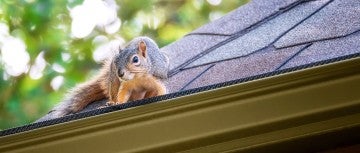
How can I get a squirrel out of my chimney?
Sometimes squirrels enter chimneys and are unable to climb back out, forcing them to try to get out from a fireplace or basement ducts. Assume that the squirrel you hear scrambling in a chimney is trapped, unless you’ve got clear evidence that they can climb back out on their own.
Never try to smoke a squirrel or any other animal out of a chimney—a trapped animal or babies too young to climb out may die a cruel death and then you’ll also have a decomposing animal in your chimney. Try these methods instead:
- Provide an escape route: Hang a three-quarter-inch or thicker rope down the chimney. Tie one end of the rope to the top of the chimney before lowering the other end and make certain that the rope is long enough to reach the damper or smoke shelf. Don’t lower anything into the chimney that you can’t easily retrieve. The squirrel will climb up the rope and escape, usually within a few (daylight) hours. Once you’re certain that the squirrel has escaped, remove the rope and cap the chimney with a commercially-made cap.
- Catch and release: If the squirrel cannot or will not leave a fireplace behind glass or a screen, the next best option is a suitable live trap.
- Before opening the doors of the fireplace to set the trap, close any interior doors in the room and open an exterior door or window in line of sight from the fireplace, if possible, so the squirrel has a way out. If the squirrel gets out of the fireplace, do not chase it.
- Bait a humane live trap with peanut butter and set it very carefully inside the fireplace. Most squirrels will retreat to a back corner of the fireplace as the doors are opened and stay there if you place the live trap slowly and quietly just inside the doors.
- Close the doors and leave the room to wait for the squirrel to enter the trap.
- Take the squirrel outside and carefully open the trap door while standing behind the trap. The squirrel will usually bolt immediately out of the trap. If not, you can wedge the door open or tie it open with a zip tie and stand back to let the squirrel leave on their own.
- Call a professional: If more immediate and direct intervention is required to evict squirrels, hire professional assistance for your and the squirrel’s safety.
Once you’ve evicted a squirrel, have a chimney cap installed as soon as it is practical to do so. Ask a local certified chimney sweep about any local building codes regarding cap installation and check these recommendations for good venting practices.
What do squirrels eat? What should I feed squirrels?
Squirrels are adaptable, opportunistic eaters, but they prefer nuts, seeds, vegetables and fruit, such as berries. Like most wild animals, you don’t need to feed them and you may compromise their survival skills if you do so. What wild animals, including squirrels, need most is water. Consider maintaining a clean bird bath in the summer and a clean, heated bird bath that won’t freeze in the winter. Once wildlife finds your water source, you’ll be rewarded with wildlife watching galore!
Are squirrels harmful?
Squirrels can harbor pathogens (such as salmonella) that may be harmful to people, but transmission has rarely, if ever, been documented. Just like in any mammal, rabies can occur in squirrels, but there is no documented case of any person getting rabies from a squirrel.
